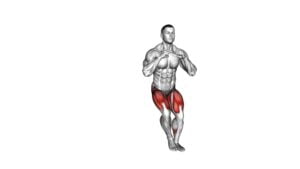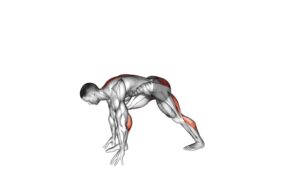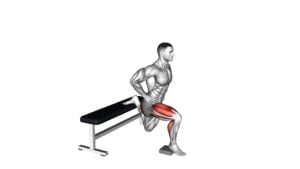Heel Press – Video Exercise Guide & Tips

Looking to strengthen your legs and improve your lower body flexibility? Look no further than the Heel Press exercise.
Watch This Exercise Video
In this video exercise guide, we'll show you the proper form and technique, as well as common mistakes to avoid. Whether you're a beginner or an experienced fitness enthusiast, we've got modifications and advanced variations to suit your level.
Get ready to maximize your results and achieve your fitness goals with the Heel Press. Let's get started!
Key Takeaways
- Heel press targets muscles in the lower body, particularly the calves and glutes.
- It improves muscle strength, endurance, and flexibility.
- Variations can be added to increase intensity and target different areas of the calf muscles.
- Proper form and technique, including maintaining alignment and avoiding jerking movements, are crucial for safety and effectiveness.
Benefits of the Heel Press
Get ready to experience the numerous benefits of incorporating the heel press into your workout routine. The heel press is a versatile exercise that targets the muscles in your lower body, particularly your calves and glutes. By performing this exercise regularly, you can expect to see improvements in muscle strength, endurance, and flexibility.
One of the key benefits of the heel press is its ability to strengthen your calf muscles. This exercise specifically targets the gastrocnemius and soleus muscles in your calves, helping to build lean muscle mass and increase overall calf strength. Additionally, the heel press also engages your glutes, which can help improve your overall lower body strength and stability.
Another advantage of the heel press is its ability to provide variations to your workout routine. You can perform this exercise using a variety of equipment, such as dumbbells, resistance bands, or even just your body weight. Additionally, you can also modify the intensity of the exercise by adjusting the range of motion or the speed at which you perform the movement.
Now that you understand the benefits of the heel press, it's important to focus on proper form and technique to maximize its effectiveness and minimize the risk of injury.
Proper Form and Technique
To ensure optimal results and reduce the risk of injury, it's crucial to maintain proper form and technique while performing the heel press exercise. Many people have common misconceptions about this exercise, which can lead to ineffective results or even injuries. By understanding the correct form and technique, you can maximize the benefits of the heel press while minimizing the risk of harm.
First and foremost, it's important to position yourself correctly. Start by lying flat on your back with your knees bent and your feet flat on the ground. Place your hands by your sides for support. As you lift your hips off the ground, focus on pressing through your heels, engaging your glutes and hamstrings. Remember to keep your core tight throughout the movement to maintain stability.
Additionally, proper breathing is essential for injury prevention. Exhale as you lift your hips off the ground and inhale as you lower them back down. This helps to stabilize your core and prevent unnecessary strain on your lower back.
Common Mistakes to Avoid
One common mistake to avoid when performing the heel press exercise is allowing your knees to collapse inward. This can put unnecessary strain on your knee joints and increase the risk of injury. To prevent this, focus on maintaining proper alignment by keeping your knees in line with your toes throughout the exercise. Engage your core muscles to stabilize your pelvis and prevent any excessive inward movement.
Another mistake to avoid is rushing through the exercise. Take your time and perform the heel press slowly and controlled. This won't only help you avoid injury but also improve your balance and stability. By moving with control, you engage the muscles more effectively and get the most out of the exercise.
It's important to avoid leaning forward or backward during the heel press. This can throw off your balance and compromise the effectiveness of the exercise. Keep your torso upright and aligned with your hips, and focus on pressing your heels into the ground while maintaining a stable position.
Modifications for Beginners
If you're new to the heel press exercise, there are some modifications you can make to simplify the movement. These variations can help you build a strong foundation and avoid common beginner mistakes.
Simplified Exercise Variations
Start with a few basic variations of the heel press exercise to help you ease into the workout. These beginner-friendly exercises are effective modifications that will allow you to build strength and improve your form gradually.
One modification is to perform the exercise while seated on a chair or bench. This reduces the amount of weight you have to press and provides more stability.
Another modification is to use a resistance band instead of weights. This decreases the intensity of the exercise while still targeting the same muscle groups.
Additionally, you can start by performing fewer repetitions or using lighter weights until you feel comfortable progressing to the full exercise.
Remember to listen to your body and adjust as needed to prevent injury and ensure a successful workout.
Building a Strong Foundation
To establish a solid base for your workout, incorporate modifications suitable for beginners that will help you progressively build strength and improve your form during the heel press exercise.
These modifications are essential for beginners as they provide the necessary support and stability needed to perform the exercise correctly and safely.
By focusing on building a strong foundation, you can ensure that your body is prepared for more advanced variations of the heel press in the future.
Additionally, these modifications also emphasize the importance of core strength, as a strong core is crucial for maintaining stability during the exercise.
Avoiding Common Beginner Mistakes
To avoid common mistakes as a beginner, focus on incorporating modifications into your heel press exercise routine for improved form and stability. Here are some beginner modifications to help you get started:
- Start with a lighter resistance band to build strength gradually.
- Use a mirror or ask a friend to check your form to ensure proper alignment.
- Begin with a shorter range of motion and gradually increase it as you become more comfortable.
By incorporating these modifications, you can prevent common errors such as using too much resistance, having improper form, or overexerting yourself. These modifications will allow you to develop a solid foundation and avoid potential injuries.
Now that you understand the importance of beginner modifications, let's move on to the next section about advanced variations for experienced fitness enthusiasts.
Advanced Variations for Experienced Fitness Enthusiasts
For experienced fitness enthusiasts, take your heel press exercise to the next level with advanced variations. These advanced modifications are designed to provide a greater challenge and push your muscles to their limits.
One challenging variation is the single-leg heel press. Instead of using both legs, lift one leg off the ground and perform the exercise with only the other leg. This variation not only increases the difficulty but also engages your core and improves balance.
Another advanced variation is the heel press with resistance bands. By adding resistance bands around your thighs, you'll increase the resistance and intensity of the exercise, targeting your glutes and hamstrings even more.
Additionally, you can try the heel press on an unstable surface, such as a Bosu ball or a foam mat. This will require your muscles to work harder to stabilize your body, further enhancing the effectiveness of the exercise.
Tips for Maximizing Your Results
To maximize your results, incorporate these tips into your heel press routine:
- Avoiding Plateaus: To prevent your progress from stagnating, it's important to vary your heel press workout. Add different variations and intensities to challenge your muscles and keep them guessing. This could include increasing the weight, changing the tempo, or trying different foot positions.
- Incorporating Progressive Overload: Progressive overload is key to continuously improving your strength and muscle growth. Gradually increase the resistance or intensity of your heel press exercises over time. This can be done by adding more weight, performing more repetitions, or increasing the duration of your sets.
- Listen to Your Body: Pay attention to how your body feels during and after your heel press workout. If you experience any pain or discomfort, adjust your technique or reduce the weight. It's important to push yourself, but not at the expense of your safety and well-being.
Frequently Asked Questions
How Many Sets and Repetitions Should I Do When Performing the Heel Press Exercise?
When performing the heel press exercise, it's important to consider the number of sets and repetitions. The number of sets and repetitions can vary depending on your fitness level and goals.
It's recommended to start with 2-3 sets of 10-15 repetitions and gradually increase as your ankle strength improves.
The heel press exercise is great for improving ankle strength and stability, which can have a positive impact on your overall balance and athletic performance.
Can the Heel Press Exercise Help Improve Ankle Flexibility?
The heel press exercise has numerous benefits, including improving ankle flexibility. By regularly performing this exercise, you can increase the range of motion in your ankles, making them more flexible and reducing the risk of injuries.
Additionally, there are variations of the heel press exercise that can further enhance ankle flexibility. For example, performing it on an incline or with resistance bands can provide even greater benefits.
Incorporating these variations into your routine can provide even greater benefits for your ankle flexibility.
Is There a Recommended Rest Time Between Sets of Heel Press Exercises?
To maximize the benefits of the heel press exercise, it's important to consider the recommended rest time between sets. This rest period allows your muscles to recover and prepares them for the next set.
The duration of rest time can vary depending on your fitness level and goals, but typically it's recommended to rest for about 30 to 60 seconds between sets.
Remember to also consider the recommended sets and repetitions for this exercise to achieve optimal results.
Can the Heel Press Exercise Be Incorporated Into a Full-Body Workout Routine?
Yes, the heel press exercise can be easily incorporated into a full-body workout routine.
It's a versatile exercise that can target multiple muscle groups, including the calves, hamstrings, and glutes.
By adding variations such as single-leg heel press or weighted heel press, you can increase the intensity and challenge your muscles even more.
The benefits of the heel press exercise include improved lower body strength, enhanced balance, and increased ankle flexibility.
Are There Any Potential Risks or Precautions to Be Aware of When Performing the Heel Press Exercise?
When performing the heel press exercise, it's important to be aware of any potential risks and take necessary precautions. By understanding the possible risks, such as strain on the calf muscles or excessive pressure on the heel, you can modify the exercise to suit your fitness level.
It's always a good idea to warm up properly, maintain proper form, and listen to your body. Remember, safety should be your top priority when incorporating any exercise into your routine.
Conclusion
In conclusion, incorporating heel presses into your workout routine can offer numerous benefits.
These benefits include strengthening your lower body muscles and improving stability.
To maximize your results, it is important to follow proper form and technique.
Avoiding common mistakes is also crucial in order to prevent injury and ensure effective workouts.
Additionally, making modifications or trying advanced variations when appropriate can help you challenge yourself and continue progressing.
If you have any concerns or questions, it is always a good idea to consult with a fitness professional.
Keep up the good work!

Author
Years ago, the spark of my life’s passion ignited in my mind the moment I stepped into the local gym for the first time. The inaugural bead of perspiration, the initial endeavor, the very first surge of endorphins, and a sense of pride that washed over me post-workout marked the beginning of my deep-seated interest in strength sports, fitness, and sports nutrition. This very curiosity blossomed rapidly into a profound fascination, propelling me to earn a Master’s degree in Physical Education from the Academy of Physical Education in Krakow, followed by a Sports Manager diploma from the Jagiellonian University. My journey of growth led me to gain more specialized qualifications, such as being a certified personal trainer with a focus on sports dietetics, a lifeguard, and an instructor for wellness and corrective gymnastics. Theoretical knowledge paired seamlessly with practical experience, reinforcing my belief that the transformation of individuals under my guidance was also a reflection of my personal growth. This belief holds true even today. Each day, I strive to push the boundaries and explore new realms. These realms gently elevate me to greater heights. The unique combination of passion for my field and the continuous quest for growth fuels my drive to break new ground.







